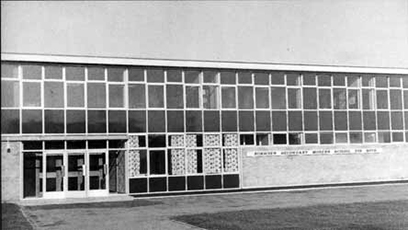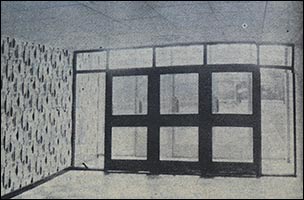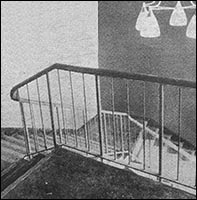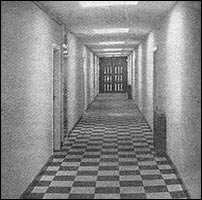The Rushden Echo and Argus, 26th April 1957, transcribed by Jim Hollis
Streamlined School Open Next Week
 |
|
The new block
|
When the new term starts on Tuesday, most of the pupils of the Rushden Secondary Modern School for Boys will be in new class rooms – and instead of looking at a blackboard they will be looking at a GREENBOARD.
Tuesday sees the opening of the new, modern-style school building in Highfield Road, as an extension to the existing buildings.
The streamlined building, pleasing to the eye and colourful, covers an area of nearly 23,000 sq. ft.
Harmony is the keynote of the scheme. Colour is used imaginatively and everything was worked out carefully and scientifically long before brush was dipped in paint.
Mr. Michael F. Tollit, senior assistant architect of the county education committee, explained the method used to determine the colour scheme to an “Echo and Argus” reporter and photographer this week.
In the early stages of planning, he said, a scale model was made. When the plans were approved the model was carefully dissected and the colour schemes were tried out individually for the rooms. The colours selected were chosen after being viewed in the sunshine if the correct effect was given.
Maroon Panels
The use of colour is the first thing noticed by the visitor. Along the outside wall at the front run two glass covered maroon panels, setting off the steel frames of the many windows.
At the end of the block the staircase is made very attractive by a wall of red and a wall of white, topped by a light blue ceiling. A modern-style chandelier adds a graceful touch and the glass doors at the bottom let in light to complete the harmonious effect.
The classrooms differ in colours, but the use of green-boards is not part of the plan to make them brighter. Green has been found to be easier on the eye and the use of yellow chalk instead of white reduces eye strain still further.
 |
 |
 |
|
New entrance
|
Stairs
|
Hallway
|
Each classroom has a radio loudspeaker, adjoining store room, electric power point and a thermostatic control. Not all the furniture will be new and on Monday volunteers from among the pupils will help to transfer desks from the present classrooms.
At the end of the airy and light corridors there are doors with plain polished planks of timber separated by two-inch-wide panels of glass. These were inspired by a study in Finland. They are strong and smart and also allow vision of people walking on the other side.
Opinions Differ
Wood becomes a talking point, again, in the main hall, where planks of strong teak protrude from the wall to act as steps to the platform with no support from underneath. This seems unusual and slightly unsafe to the stranger but “they will last longer than other things in the school,” said Mr. Tollit.
The hall itself is well equipped with lighting and curtaining facilities and no doubt there will be in the future numerous requests from various organisations to present plays and other entertainments. The wings are walled in blue brick and this caused much discussion in the planning days. Opinions among individuals still differ. The wall at the back is partly red and partly panelled in wood.
Practically everything possible in the way of equipment is installed in the gymnasium which is fitted with basketball goal-boards, wall bars, and climbing ropes. Two rows of windows on each side make the gym light and airy.
For the use of the boys after gym lessons there are showers and changing rooms and enough clothes hooks to cater for 200. Although it is not likely that there will ever be so many changing at once, the changing accommodation can be partitioned to form two rooms.
Oil-Burning
The hot water in the showers and room heat will be provided by oil-burning furnaces and the furnace room looks like a section of a small power plant. This is the first school in the county to use oil burning heating. For cooling down in the corridors there is a system of draught-free ventilation from domes in the roof.
Work is still going on with an elaborate new kitchen which will eventually replace the Rushden schools’ kitchen in Portland Road. When it is operational, meals will be taken to other schools in heat-retaining containers.
One of the walls in the new school building is papered instead of painted. It is here that a minor slip was made in the planning. The wall has an overall abstract design of glasses and jugs in black and white. In the middle is a bell-push for visitors to ring – but it is almost hidden by the striking motif. This point was noticed on Wednesday. Now it is planned to have a coloured panel for the bell-push and to put up a small sign near it.
Nine Classrooms
The opening of the new building which was started 11 months ago is four months ahead of the original schedule. While conversion of the existing classrooms for purely technical subjects is being carried out all forms will move over to the new building, but after that two of the old rooms will continue to be used. There are nine classrooms in the new extension.
“It has certainly come up to expectations” said the headmaster, Mr. L. J. Wilce, who took over at the school in 1950. Mr. Wilce will be in the new building only until the end of the next term after which he becomes headmaster of the John Lea School, Wellingborough.
|